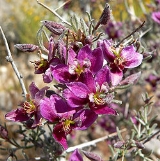
Krameria erecta
Encyclopedia
Krameria erecta is a species of rhatany
known by several common names, including Pima rhatany, purple heather, and littleleaf rhatany. It is native to the southwestern United States and northern Mexico, where it grows in dry areas such as desert flats and chaparral
slopes. This is a small, tangled shrub
under a meter in height with blunt, thorny branches covered in silky hairs and fuzzy linear leaves. The shrub flowers in the spring and again in the fall during wetter years. The showy flower has four or five bright pink cup-shaped sepals and usually five smaller, triangular petals which are pink with green bases. The three upper petals are held erect and the lower two are glandular structures next to the ovary
. Next to these are four curving stamen
s. The fruit is a furry heart-shaped body covered in pink spines. It reproduces by seed. This species and others in its genus are root parasites
, tapping the tissues of nearby plants for nutrients, especially water. This helps it survive in soil that is almost totally dry.
Rhatany
Krameria is the only genus in the Krameriaceae family, of which any of the approximately 17 species are commonly known as Rhatany, ratany or rattany...
known by several common names, including Pima rhatany, purple heather, and littleleaf rhatany. It is native to the southwestern United States and northern Mexico, where it grows in dry areas such as desert flats and chaparral
Chaparral
Chaparral is a shrubland or heathland plant community found primarily in the U.S. state of California and in the northern portion of the Baja California peninsula, Mexico...
slopes. This is a small, tangled shrub
Shrub
A shrub or bush is distinguished from a tree by its multiple stems and shorter height, usually under 5–6 m tall. A large number of plants may become either shrubs or trees, depending on the growing conditions they experience...
under a meter in height with blunt, thorny branches covered in silky hairs and fuzzy linear leaves. The shrub flowers in the spring and again in the fall during wetter years. The showy flower has four or five bright pink cup-shaped sepals and usually five smaller, triangular petals which are pink with green bases. The three upper petals are held erect and the lower two are glandular structures next to the ovary
Gynoecium
Gynoecium is most commonly used as a collective term for all carpels in a flower. A carpel is the ovule and seed producing reproductive organ in flowering plants. Carpels are derived from ovule-bearing leaves which evolved to form a closed structure containing the ovules...
. Next to these are four curving stamen
Stamen
The stamen is the pollen producing reproductive organ of a flower...
s. The fruit is a furry heart-shaped body covered in pink spines. It reproduces by seed. This species and others in its genus are root parasites
Parasitic plant
A parasitic plant is one that derives some or all of its sustenance from another plant. About 4,100 species in approximately 19 families of flowering plants are known. Parasitic plants have a modified root, the haustorium, that penetrates the host plant and connects to the xylem, phloem, or...
, tapping the tissues of nearby plants for nutrients, especially water. This helps it survive in soil that is almost totally dry.

